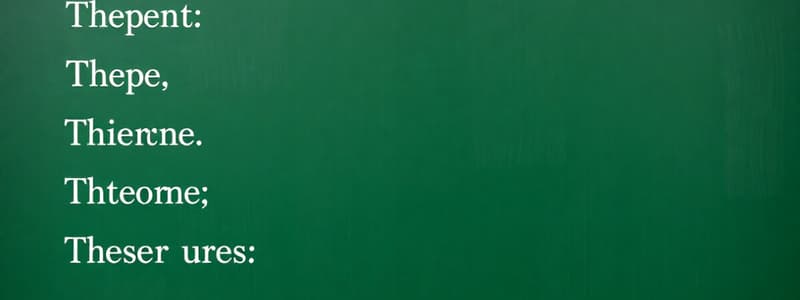Podcast
Questions and Answers
Which sentence demonstrates the correct use of a semicolon?
Which sentence demonstrates the correct use of a semicolon?
- The dog barked loudly, it chased the squirrel up the tree.
- The dog, barked loudly; it chased the squirrel up the tree.
- The dog barked loudly; it chased the squirrel up the tree. (correct)
- The dog barked loudly; and it chased the squirrel up the tree.
Identify the sentence that correctly uses commas to set off a nonessential phrase.
Identify the sentence that correctly uses commas to set off a nonessential phrase.
- My brother, who lives in Chicago is a software engineer.
- My brother who lives in Chicago, is a software engineer.
- My brother who lives in Chicago is a software engineer.
- My brother, who lives in Chicago, is a software engineer. (correct)
Which of the sentences below contains a verb in the past perfect tense?
Which of the sentences below contains a verb in the past perfect tense?
- They are playing basketball now.
- I am going to the store later.
- He will travel to Europe next year.
- She had finished her homework before dinner. (correct)
In which sentence is the subject-verb agreement incorrect?
In which sentence is the subject-verb agreement incorrect?
Select the sentence that contains a pronoun agreement error.
Select the sentence that contains a pronoun agreement error.
Which of the following sentences demonstrates correct use of coordinate adjectives?
Which of the following sentences demonstrates correct use of coordinate adjectives?
Choose the sentence that correctly uses an apostrophe to show possession.
Choose the sentence that correctly uses an apostrophe to show possession.
Which sentence uses quotation marks correctly?
Which sentence uses quotation marks correctly?
Flashcards
Verb Tenses
Verb Tenses
Different forms of verbs indicating time of action.
Present Tense
Present Tense
Describes actions happening now or general truths.
Past Tense
Past Tense
Used for actions that have already happened.
Future Tense
Future Tense
Signup and view all the flashcards
Comma Use
Comma Use
Signup and view all the flashcards
Comma Splice
Comma Splice
Signup and view all the flashcards
Subject-Verb Agreement
Subject-Verb Agreement
Signup and view all the flashcards
Pronoun-Antecedent Agreement
Pronoun-Antecedent Agreement
Signup and view all the flashcards
Study Notes
Verb Tenses
- Verb tenses indicate the time of an action or state of being.
- Present tense: used for actions happening now, general truths, habits, and scheduled events.
- Past tense: used for actions that happened before now.
- Future tense: used for actions that will happen after now.
- Perfect tenses (present perfect, past perfect, future perfect): indicate actions completed before or by a particular time. They emphasize the completion of an action.
- Continuous tenses (present continuous, past continuous, future continuous): used to describe actions in progress at a specific time.
- Modal verbs (can, could, should, would, may, might, must): express ability, possibility, permission, obligation, or suggestion.
Punctuation: Comma Use
- Commas separate items in a series: "apples, oranges, and bananas."
- Commas separate independent clauses joined by coordinating conjunctions (and, but, or, nor, for, so, yet): "I went to the store, but I forgot my wallet."
- Commas set off nonessential phrases and clauses: "My sister, who is a doctor, works in the city."
- Commas are used after introductory phrases or clauses: "After finishing my work, I went to the park."
- Commas separate coordinate adjectives describing the same noun; "a tall, slender woman"
- Avoid comma splices: Using a comma to connect two independent clauses creates a comma splice. Connect them with a conjunction or semicolon.
- Avoid a comma that is not needed to separate items in a series.
Punctuation
- Periods: used to end declarative sentences and abbreviations.
- Question marks: used to end interrogative sentences.
- Exclamation points: used to show strong emotion.
- Colons: used to introduce a list, explanation, or example.
- Semicolons: used to connect closely related independent clauses.
- Parentheses: used to enclose extra information or asides.
- Quotation marks: used around direct quotes, titles of short works (poems, articles).
- Apostrophes: show possession, contractions, or an omission
Grammar
- Subject-verb agreement: the subject and verb of a sentence must agree in number.
- Pronoun-antecedent agreement: a pronoun must agree in number and gender with the noun it refers to.
- Verb form consistency : Maintain a consistent tense throughout a sentence or paragraph.
- Noun and pronoun cases (nominative, objective, possessive): Use the correct case to indicate a noun's role in the sentence.
- Correct use of articles (a, an, the) and prepositions.
- Understanding sentence structure (simple, compound, complex, compound-complex)
- Use of active voice versus passive voice— choose the best voice for clarity.
- Identifying and correcting sentence fragments and run-on sentences.
- Ensuring clarity and concision to avoid ambiguity and confusion in your writing.
Studying That Suits You
Use AI to generate personalized quizzes and flashcards to suit your learning preferences.




